

Mummification. Egyptian Mummies. Ancient Egyptian Games To understand Egyptian mummies you have to first know about their religious beliefs.
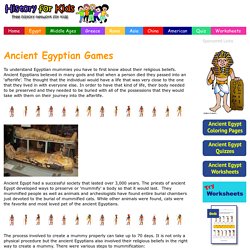
Ancient Egyptians believed in many gods and that when a person died they passed into an ‘afterlife’. The thought that the individual would have a life that was very close to the one that they lived in with everyone else. In order to have that kind of life, their body needed to be preserved and they needed to be buried with all of the possessions that they would take with them on their journey into the afterlife. Ancient Egypt had a successful society that lasted over 3,000 years. The process involved to create a mummy properly can take up to 70 days. 1} The body must be purified and washed. 2} All internal organs were removed, however, they left the heart in place. 3} They filled in the body with a kind of stuffing so that it would look normal. 4} They had to ‘dry’ the body out, so they placed it in a naturally found substance called ‘natron’.
Sponsored Links. How to Make a Mummy! - National Geographic Kids. Want to make sure a body gets reunited with its spirit in the afterlife?
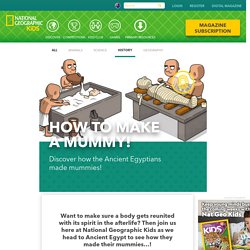
Then join us here at National Geographic Kids as we head to Ancient Egypt to see how they made their mummies…! 1. First wash the dead body in wine and Nile water. Make a cut in the side and take out the organs. To get to the brain, shove a hook up the nose and jiggle it about. 2. 3. 4. 5. Cool but creepy, eh?! * They had some funny ideas, those Ancient Egyptians! Illustrations: Marek Jagucki Be sure to read our other fab features about Ancient Egypt, too…
Ancient Egypt for Kids and Teachers. Sequence Chain: Mummification. Ceremony: Ceremony by 4 priests, one dressed as Anubis.

The inner organs were removed and put in Canopic jars. Natron: Linen cloth and natron were used as packing to replace the organs. 40 Days: The body was covered with natron and placed on a tilted slab. Horrible Histories The Pharoh Report. Ancient Egypt For Kids. Egyptian boats Egyptian boats.

The Ancient Egyptians. To understand the great and magnificent ancient Egypt requires great effort due to the detailed and intricate society they constructed.
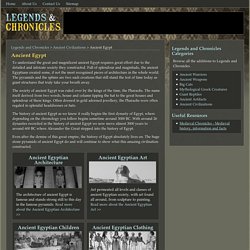
Full of splendour and magnitude, the ancient Egyptians created some, if not the most recognised pieces of architecture in the whole world. The pyramids and the sphinx are two such creations that still stand the test of time today as giant structures that truly take your breath away. The society of ancient Egypt was ruled over by the kings of the time, the Pharaohs. The name itself derived from two words, house and column tipping the hat to the great houses and splendour of these kings. Often dressed in gold adorned jewellery, the Pharaohs were often regaled in splendid headdresses or hats. In the Land of the Pyramids Quiz.
Ancient Egypt for Kids - History Games and Videos. Ancient Egypt for Kids Ancient Egypt was a civilization that thrived for over 3000 years along the Nile River in northeastern Africa.

It was the longest-lived civilization of the ancient world, reigning from 3150 BC to 30 BC. The ancient Egyptians developed a sophisticated writing system, a system of medicine and very effective irrigation and farming techniques. They developed a system of mathematics and advanced construction techniques that helped them build monumental pyramids, temples and other huge structures. Ancient Egyptians left a huge cultural legacy for the whole world.
History Games, Diagrams & Activities : Pictures & School Presentations : History Videos & Lessons:(Reviewed by K-12 teachers) Search Videos Suggest History Videos. Search Results (Egypt, page 1) World History: Ancient Egypt for Kids. Back to History Ancient Egypt was one of the greatest and most powerful civilizations in the history of the world.
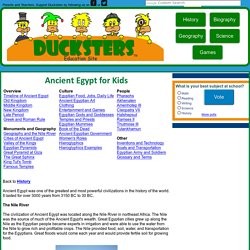
It lasted for over 3000 years from 3150 BC to 30 BC. Ancient Egyptian History for Kids - Fun Facts to Learn. Ten Facts About Ancient Egypt. Country fact file: Egypt todayIncredible ancient monuments, scorching deserts and bustling cities – this ancient country is now a sprawling, modern landscape!
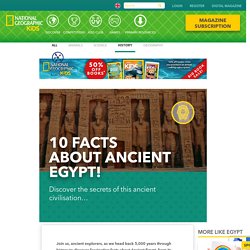
Read on to learn about the Egypt of today… Egyptian flag OFFICIAL NAME: Arab Republic of EgyptFORM OF GOVERNMENT: RepublicCAPITAL: CairoPOPULATION: 87, 562, 261OFFICIAL LANGUAGE: ArabicMONEY: Egyptian pound, guinayAREA: 1,001,449 square kilometresMAJOR MOUNTAIN RANGES: Eastern HighlandsMAJOR RIVER: NileFLAG: Map of Egypt Egypt: geography and landscape Without the Nile River, all of Egypt would be desert. Only about an 2.5cm of rain falls throughout Egypt each year. But each summer, the Nile river rises because of rains at its source, far to the south in Ethiopia. When this happens, floods cover the river’s valleys, leaving sediments needed for trees, plants and crops to grow.Egypt is often divided into two sections – Upper Egypt in the south and Lower Egypt in the north.
World History: Ancient Egypt for Kids. Ancient Egypt for Kids and Teachers. Kid's Animated History Egypt. Journals Through History Ancient Egypt Constructing Civilization. Egypt - A Journey Down The Nile. A Journey Deep Inside The Great Pyramid Of Egypt. BBC Bitesize - KS2 History - Ancient Egypt Class Clips, Page 1. Ancient Egypt for kids - History at Super Brainy Beans. Share Ancient Egypt for kids learning in KS2 at Primary School.
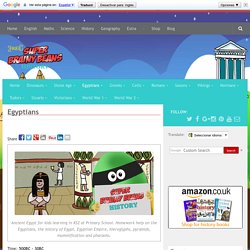
Homework help on the Egyptians, the history of Egypt, Egyptian Empire, hieroglyphs, pyramids, mummification and pharaohs. Time: 500BC – 30BC. Ancient Egyptian Schools for Kids - Fun Facts. Egyptian School Formal education in ancient Egypt was mostly reserved for the boys of wealthier families.
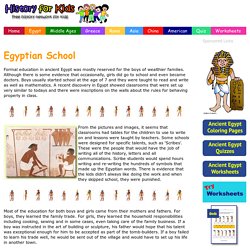
Although there is some evidence that occasionally, girls did go to school and even became doctors. Boys usually started school at the age of 7 and they were taught to read and write as well as mathematics. A recent discovery in Egypt showed classrooms that were set up very similar to todays and there were inscriptions on the walls about the rules for behaving properly in class. From the pictures and images, it seems that classrooms had tables for the children to use to write on and lessons were taught by teachers. Most of the education for both boys and girls came from their mothers and fathers. If a boy attended a formal school they began at the lower grades, what we might consider kindergarten. A majority of the Egyptian population did not receive any kind of formal education. Some young girls were educated in both a formal manner and by their mothers.